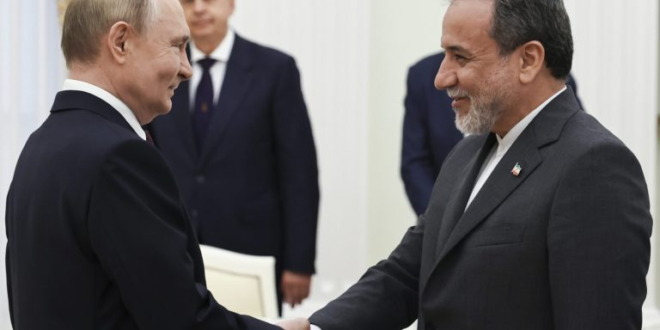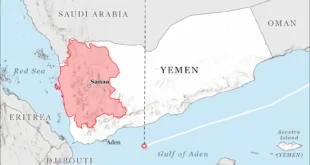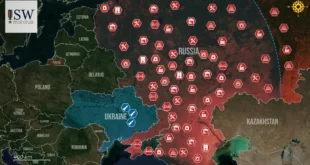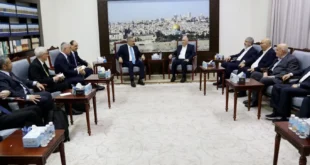Iranian Foreign Minister Abbas Araghchi met with Russian President Vladimir Putin in Moscow on Monday — a meeting that underscored the trilateral relationship between Russia, China, and Iran.
Iran is a geopolitical lever for both Moscow and Beijing, allowing them to complicate Western strategies in the Middle East, even as they balance support for Iran with broader regional interests.
If the U.S. brokered ceasefire collapses and the conflict continues to intensify, Russia and China would face a strategic dilemma.
While useful as a pressure point against U.S. dominance and a shield for economic survival under sanctions, the Iran-Russia-China alliance is limited in scope.
Iranian Foreign Minister Abbas Araghchi met with Russian President Vladimir Putin in Moscow on Monday. During the meeting, both leaders emphasized the strength of their ties and condemned what they called a “completely unprovoked act of aggression” by Israel and the United States. While Russia has offered Iran moral support, many are left wondering what, if anything, it will provide in terms of assistance — particularly given the strategic cooperation agreement signed in January, which notably omitted a mutual defense clause. At the same time, Russia, in partnership with China, pushed for a ceasefire at the UN Security Council on Sunday, ahead of Iranian strikes on the U.S. base in Qatar and the tenuous ceasefire deal brokered by U.S. President Donald Trump on Monday night.
This strategic coordination underscores the growing significance of the trilateral relationship between Russia, China, and Iran — one of the most consequential geopolitical alignments in today’s international system. Frequently characterized as a “tactical alliance,” this partnership has gained momentum in recent years, driven by a shared interest in curbing Western — particularly U.S. — strategic dominance and fostering a multipolar global order.
As global tensions escalate — driven by the war in Ukraine, the intensifying strategic competition between Washington and Beijing, expanding Western sanctions on Moscow and Tehran, and the Iran-Israel war that involved U.S. strikes on Iranian nuclear facilities — the strategic alignment between Russia, China, and Iran has become increasingly consequential. These developments not only threaten to reshape regional power dynamics but also carry broader implications for China’s international initiatives, like the Belt and Road Initiative (BRI), the Global Security Initiative (GSI), and the Global Development Initiative (GDI), as well as Russia’s strategic posture across Eurasia.
The three states find common cause in rejecting Western hegemony and advocating for a multipolar system — a vision reinforced by the fallout of the 2022 Ukraine war and growing tensions in the South China Sea. Iran’s accession to the Shanghai Cooperation Organization (SCO) during the heads of state summit in Tajikistan in 2021 exemplifies this alignment. For Tehran, SCO membership provides diplomatic cover amid intensifying sanctions following the U.S. withdrawal from the nuclear deal in 2018. Yet this tactical convergence reflects immediate strategic calculations more than a cohesive worldview. Despite the convergence of anti-Western rhetoric, the partnership lacks a shared ideological foundation.
Russia and China have used the principle of “sovereignty” and “non-intervention” to oppose unilateral Western sanctions on Iran, especially in multilateral forums. However, this commitment is selective. Russia’s 2022 full-scale invasion of Ukraine and China’s increased aggression in the South China Sea and the Taiwan Strait exposes fundamental contradictions. Sovereignty, in this context, serves as a political tool rather than a principled stance. Iran functions as a geopolitical lever for both Moscow and Beijing, allowing them to complicate Western strategies in the Middle East. However, their security commitments to Tehran so far remain limited and calculated.
For Russia, Iran offers a valuable front to stretch U.S. attention and resources away from the critical Ukrainian theater. For China, Iran acts as a buffer against expanded U.S. presence in Central Asia and the Gulf, while also securing overland energy routes vital to Beijing’s economic and security interests. Nevertheless, Iran’s role is inherently tactical — it is a tool that may be leveraged or discarded based on broader strategic priorities.
To date, Moscow has refrained from delivering more advanced military systems to Tehran to avoid provoking Israel. China has provided surveillance technologies but maintains a delicate balance to preserve its ties with Gulf energy suppliers. The limited nature of this military support highlights a deliberate policy of “calculated avoidance” of direct confrontation with the United States or its allies.
Beneath the surface, the partnership is marked by latent rivalry. China monitors Russian-Iranian military coordination in Central Asia with concern, viewing it as a potential threat to Beijing’s increasing influence in the region. Moscow also views Beijing with suspicion, including China’s economic and soft power inroads in what Russia perceives as its traditional sphere of influence and Chinese activities in the Arctic. This underlying competition constrains deeper strategic integration, with economic cooperation among the three countries focused on energy and sanctions evasion. However, significant asymmetries, particularly in trade balances, underscore Iran and Russia’s growing economic dependence on China.
China remains a primary consumer of Iranian oil, benefiting from steep discounts — up to 30 percent—since U.S. sanctions intensified in 2019. China is Iran’s largest crude importer with approximately 14 percent of its imports this year originating from Iran, according to Reuters. However, Moscow views Tehran as a potential competitor in Asian energy markets, especially after pivoting eastward in response to EU sanctions.
The three countries have intensified efforts to bypass Western sanctions by developing alternative financial systems and logistical networks, including increased trade in yuan and rubles and the use of Caspian Sea routes. These efforts reflect a broader attempt to reduce reliance on the Western-dominated financial infrastructure and ensure economic resilience.
While China capitalizes on discounted Russian energy, it remains cautious not to provoke a full-scale trade war with the United States. Russia, in turn, aims to turn the Middle East into a theater of strategic distraction for Washington. Iran, facing acute pressure from both Israel and the West, views this alignment as a buffer — but understands its limitations. The trio employs a strategy of attrition aimed at weakening U.S. influence in key regions without triggering a direct conflict. This includes using Iran as a geopolitical irritant while securing long-term energy and trade interests. Beijing also capitalizes on U.S. military involvement in the Iran-Israel war and material support for Ukraine by touting narratives in bilateral and multilateral forum suggesting that China, not the United States, is the responsible global power.
Iran is a pivotal node in China’s Belt and Road Initiative, offering overland corridors that bypass strategically vulnerable maritime routes. Beijing views Iran as a critical component of its broader efforts to secure alternative trade routes — especially important given the potential volatility of chokepoints like the Strait of Hormuz or Bab el-Mandeb. China’s investments in Iranian infrastructure — such as the China-Iran rail corridor — reflect a strategic interest in enhancing the reliability of its energy supply chains. Similar to China’s infrastructure investments in Pakistan, Iran is not just a corridor but a critical piece in China’s energy diversification strategy. The development of land-based routes mitigates the risk of maritime disruption, including in the Strait of Malacca, reinforcing Tehran’s geoeconomic value.
Both Russia and China must delicately balance their support for Iran with their broader regional interests. The necessity of maintaining strong ties with regional powers such as Saudi Arabia and Türkiye limits the scope of Russian and Chinese support for Tehran. Their engagement with Iran is therefore carefully calibrated to avoid alienating other key partners. Rather than choosing sides, both countries favor a policy of regional non-alignment — maintaining pragmatic relations across rival blocs to maximize economic and diplomatic flexibility.
The ongoing military escalation between Iran and Israel has exposed the limitations of the Russia-China-Iran axis. Both Moscow and Beijing recognize that a collapse of the Iranian regime could destabilize the region and jeopardize critical energy flows. It remains to be seen if either country would be willing to engage in direct military support to avoid the threat of regime change in Tehran.
If the U.S. brokered ceasefire collapses and the conflict continues to intensify, Russia and China would face a strategic dilemma. Inaction would risk the unraveling of their tactical alliance with Iran, exposing them to significant strategic, political, and economic vulnerabilities. While neither is likely to seek a full-scale confrontation with the West, the pressure to provide the regime in Tehran with sufficient support to preserve the status quo is mounting. The objective is not necessarily to ensure victory, but to maintain a level of deterrence that prevents regime collapse and sustains their collective geopolitical posture.
These developments are likely to shape the next phase of global power alignment, with three plausible scenarios emerging. First, the most probable scenario sees Moscow and Beijing sustaining political backing for Iran while avoiding deeper military entanglements. This reflects the pragmatic, interest-driven nature of the trilateral relationship, aimed at preserving leverage without escalating into direct confrontation with the U.S.
Second, Should Iran face existential threats, both Russia and China may feel compelled to step up their support — likely through indirect means such as arms transfers, intelligence sharing, or cyber cooperation — to prevent regime collapse. Such action would serve to uphold deterrence while minimizing the risk of direct engagement with Western powers.
Third, a collapse of the regime in Tehran will end the alliance. In such a scenario, Moscow and Beijing may recalibrate their priorities, shifting focus toward improved ties with Western and Gulf states to safeguard their broader strategic interests.
Ultimately, the Russia-China-Iran relationship remains a fragile tactical coalition driven by converging interests rather than shared values. While useful as a lever against U.S. dominance and a shield for economic survival under sanctions, the alliance is inherently limited in scope. The ongoing conflict highlights these constraints, revealing a relationship shaped more by caution and pragmatism than solidarity or strategic depth.
 Eurasia Press & News
Eurasia Press & News




